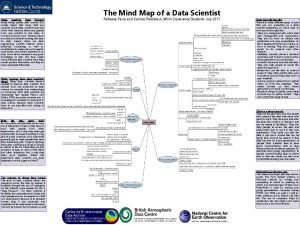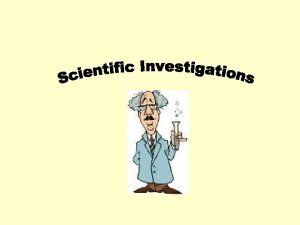The Mind Map of a Data Scientist What

- Slides: 1

The Mind Map of a Data Scientist What qualifies Data Science? Many things qualify data science; this simply means that many skills are required. Not all data scientists have the same skills, because these vary greatly from one scientist to the other in function of his/her work. Therefore there about six domains existing that lead to data science, these are data engineering, scientific method, maths, advanced computing as well as visualisation for researchers who need to spot trends, and domain expertise in an area, it can be for example a very good knowledge of data. We have asked many different data scientists were they would position themselves and they all have responded differently. What training have data scientists done? Many data scientists haven’t studied to become data scientist, but derived from one profession to data science, for example from meteorology or astronomy. Most data scientists we interviewed had studied Physics and Maths. PHDs are quite common too. A knowledge of computers is important in data science, because many scientists have to use algorithm and coding in their work. Who do they work with? For many data scientists their work is very much externally focused as they have to work with people from other departments, this is why they often get opportunities for travel. Travelling is a big part of a data scientists’ work, when they generally get to meet people they have been interacting with. Projects involving many data scientists are based in Europe as well as in the US. Universities are also providers of data, as well as Met Office and other institutions; this is why they often work together. Within the department data scientists are quite dependant on the support of the IT. The outputs of doing data science The work of data scientists allows the people to access the data by making it available through the use of catalogues on the internet, some people call this a “Data Museum”. For other scientists it facilitates the comprehension of data, and even people who are not experts in a field can understand it. Because of its standard format, data is also preserved, and hopefully will be understood in the future, not only by humans but computers as well. Rebecca Perry and Carlota Valdivieso, Work Experience Students July 2013 What work do they do? There are many different types of jobs that you can undertake as a data scientist depending on which field of work you want to get into: • There are managerial jobs which deal with management and organisation. They also do work on citation and publication and give presentations to teach people about the use of data as a form of training. They also apply for grants to do research and other projects. • Metadata scientists devise a standard vocabulary and format in order to allow future generations to use the data. • Archivists store and look after the data. They also help people to locate the data and organise it. • Researchers use the data to conduct research. They often publish their work in academic journals where their work is peer reviewed. • Science support create tools to enable others to write the metadata. They create formats so that future generations can easily use the data. • People in charge of quality control help to avoid any corruption of data. They also control the usage of data. What is a data scientist? They are the glue that joins the people who produce the data with those who want to use it. They store and look after the data like curators or librarians and can be viewed as facilitators. They also help people to access the data and advise them how to use it in their own applications. They make sure that the data is put into a format that can be easily read, not just by experts in that field but also by future generations of people. Data scientists have to have good communication skills as they interact with lots of different people. For example when giving presentations to people, communicating ideas to clients and so that the clients can feel more comfortable handing over their data. What software do they use? The software packages that they use are varied. The most utilised software is Microsoft outlook for writing and responding to emails as speaking to clients is an important part of their work. Power. Point is used for making and giving presentations. Computer coding (HTML and XML) are used as well as other software such as Python, and Mat lab. The use of computers helps to standardise the information and make the process a lot more efficient.

